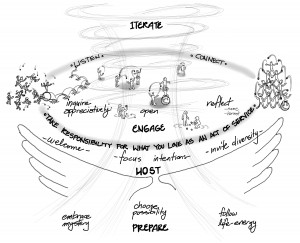I’m not afraid of storms, for I’m learning how to sail my ship.
—Louisa May Alcott, Little Women
A practice is a skill honed through study and experimentation. As every athlete or artist knows, practice takes discipline to develop both craft and artistry.
The practices for engaging emergence are rooted in skills of everyday conversation. Therefore, we all know something about them. They are our birthright.
The practices I highlight in this section consistently appear in the emergent change processes I use and those I have studied. When the issues are complex, the stakes are high, and emotions are right below the surface, these practices help us to engage.
Because working with emergence has nothing A-to-B-to-C about it, no one right way exists to use these practices. So part 2 is not an instruction manual. And while the practices won’t tell you specifically what to do, they will tell you how you might approach different situations. They help us identify what to notice, what to explore, what to try. They are helpful hints for flying by the seat of our pants.
Just as scales prepare a musician and drills train an athlete, these practices equip us for the challenging conversations, the ones with disruption, difference, and the unknown. The practices are the conversational backbone for improvisation, enabling us to stay in the flow even if we don’t know the specific path we’re taking. Honing these conversational skills is how we engage emergence.
Occasionally I’ll speak as if a practice were more solid and mapped out than it is. But I’ll warn you now: don’t believe it. We are at a growing edge of understanding how to engage emergence. Take what I say and give it a try. Experiment and share what you learn with as much humility (even when it’s tinged with excitement) as you can muster. That’s what I am doing my best to do.
Practices for Engaging Emergence1
Illustration by Steven Wright
I have organized the practices into five groups:
Step Up
Take responsibility for what you love as an act of service. This practice is a game-changing skill. It liberates our heart, mind, and spirit. It calls us to put our unique gifts to use for ourselves, for others, and for the systems that matter to us. The more this practice becomes our operating norm, the more innovation, joy, solidarity, generosity, and other qualities of well-being appear. The capacities for listening and connecting grow through this practice.
Prepare
The practices embrace mystery, choose possibility, and follow life-energy cultivate a composed state of mind, alert to aliveness and potential. They enable us to face whatever shows up with equanimity or even delight.
Host
Focus intentions and welcome are skills of being a good host. They create “containers”—hospitable spaces for working with whatever arises. They are the yin and yang of hosting. One emphasizes clear direction and purpose; the other ensures fertile ground for relationships and connection.
Invite diversity encourages us to look beyond our habitual definitions of who and what makes up a system. It prepares us for innovation by increasing the likelihood of productive connections among people with different beliefs and operating assumptions. Inviting diversity is one of the most time-consuming, challenging, and critical activities of engaging emergence.
Step In
Inquire appreciatively is a second game-changing skill. The questions we ask determine the answers we uncover, shaping our experience, actions, and outcomes. Typically, the more positive the inquiry, the more life-affirming the outcome.
Open to the unknown. This practice is an act of faith. Once open, we can’t go back. It may be the most countercultural practice of them all, requiring the courage to be vulnerable.
Reflect, name, and harvest can be sacred acts. They call forth that which previously didn’t exist. The arts—music, movement, painting, sculpture, poetry, film—often enhance the effectiveness and reach of these practices.
Iterate
This practice reminds us of the never-ending nature of change. It takes time and perseverance to make its mark. Because our attention tends to get in caught in our routines, it is the most elusive of the practices.
Each practice is discussed and illustrated by a story. Tips for using the practice are also provided. So, let’s begin by stepping up to engaging emergence by taking responsibility for what we love.
Back to the Table of Contents
On to Chapter 3. Step Up: Take Responsibility for What You Love


